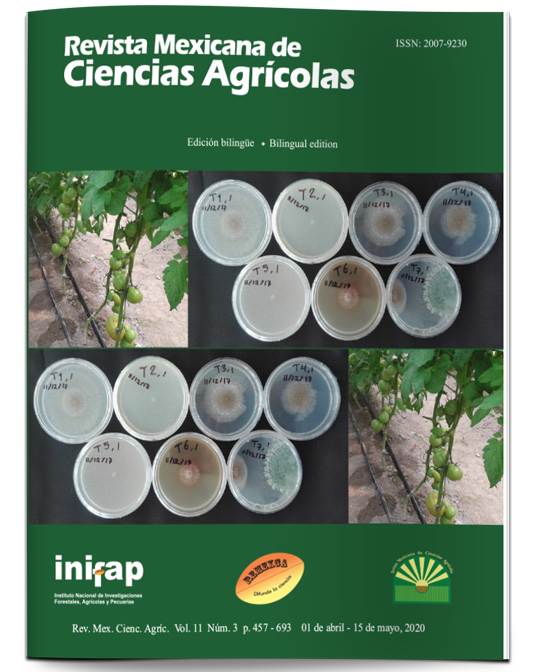Calculation of degrees days of Hypothenemus hampei through satellite images
DOI:
https://doi.org/10.29312/remexca.v11i3.2041Keywords:
coffee berry borer, degree day, monitoring, heat unitAbstract
Coffee is one of the most relevant crops in Mexico, its importance lies in the fact that it is a sustainable crop, it has been adopted and adapted by indigenous communities and generates foreign exchange for the country. One of the most important coffee growing regions in the country is the South Pacific, made up of Chiapas, Oaxaca and Guerrero where 53% of the coffee is produced and 60% of the producers of this aromatic are found. The presence of pests and diseases in coffee can generate losses between 30 to 50% of production. The Hypothenemus hampei (Ferrari) coffee berry borer is the most serious entomological problem of this crop and its presence in the country is over 40 years old, currently it is found in all states that grow coffee. That is why, in this work, a practical methodology was generated that spatially calculated the degrees days of development of the coffee berry borer through the surface temperature recorded by Modis images with a spatial resolution of 1 km and with a one-day temporary resolution, monitoring from April 01, 2018 to March 31, 2019. The results indicated that up to 13 generations of the pest could form in this region, presenting risk almost all year round, both due to development and pest spread. This methodology can help strengthen the monitoring of the pest in the country.
Downloads
Published
How to Cite
Issue
Section
License
The authors who publish in Revista Mexicana de Ciencias Agrícolas accept the following conditions:
In accordance with copyright laws, Revista Mexicana de Ciencias Agrícolas recognizes and respects the authors’ moral right and ownership of property rights which will be transferred to the journal for dissemination in open access. Invariably, all the authors have to sign a letter of transfer of property rights and of originality of the article to Instituto Nacional de Investigaciones Forestales, Agrícolas y Pecuarias (INIFAP) [National Institute of Forestry, Agricultural and Livestock Research]. The author(s) must pay a fee for the reception of articles before proceeding to editorial review.
All the texts published by Revista Mexicana de Ciencias Agrícolas —with no exception— are distributed under a Creative Commons License Attribution-NonCommercial 4.0 International (CC BY-NC 4.0), which allows third parties to use the publication as long as the work’s authorship and its first publication in this journal are mentioned.
The author(s) can enter into independent and additional contractual agreements for the nonexclusive distribution of the version of the article published in Revista Mexicana de Ciencias Agrícolas (for example include it into an institutional repository or publish it in a book) as long as it is clearly and explicitly indicated that the work was published for the first time in Revista Mexicana de Ciencias Agrícolas.
For all the above, the authors shall send the Letter-transfer of Property Rights for the first publication duly filled in and signed by the author(s). This form must be sent as a PDF file to: revista_atm@yahoo.com.mx; cienciasagricola@inifap.gob.mx; remexca2017@gmail.
This work is licensed under a Creative Commons Attribution-Noncommercial 4.0 International license.



